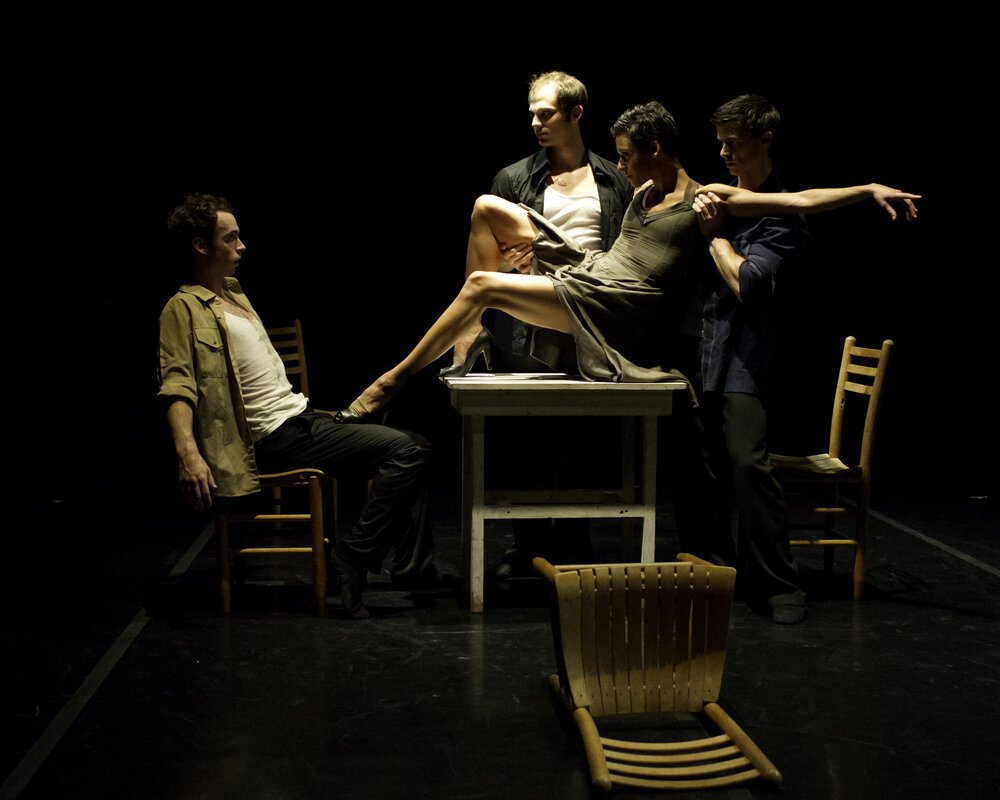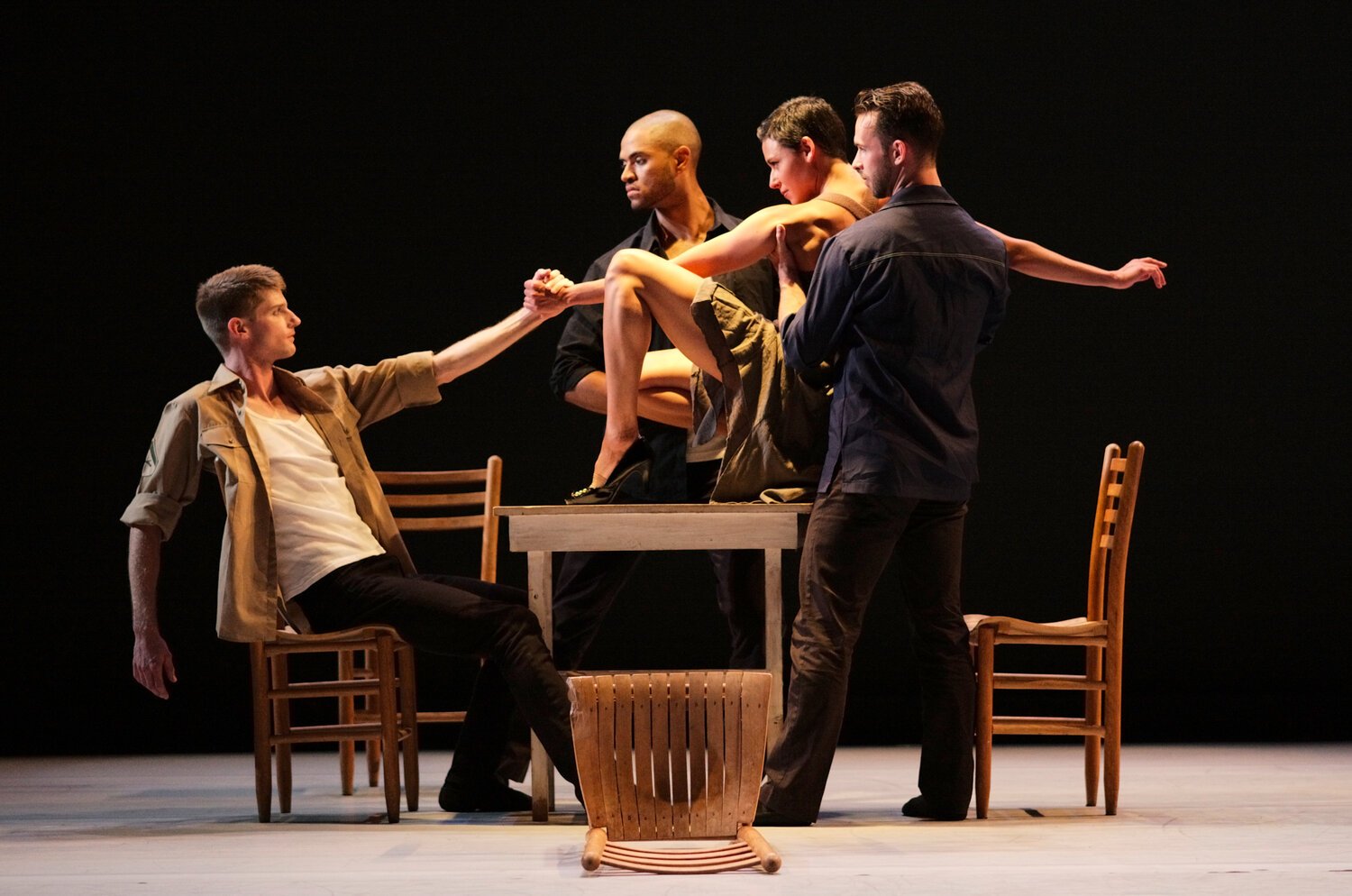SKETCH Rewind: Coming Back Around (Again)
Imagery in Cigarettes 2011 photo by David DeSilva.jpg
Imagery in Cigarettes 2011 photo by David DeSilva.jpg
2011 dancers (left to right): Ben Needham-Wood, Travis Morrison, Sarah Cecilia Bukowski, Gabe Williams
2016 dancers (left ot right): Scott Marlowe, James Gilmer, Sarah Cecilia Bukowski, Ben Needham-Wood
Image description: Two side by side photos show the same scene in two configurations: a small white table is surrounded by three wooden chairs. The closest chair to the camera lays on its back on the floor. A man in a white tank top and open brown shirt sits in the chair to the left, looking toward two men who are holding a woman in an olive green dress as she strides across the table in black high heels.
Now through July 21st, Imagery presents SKETCH: Rewind, on-demand screenings of three SKETCH favorites from the past, featuring Amy Seiwert’s “Instructions,” Jennifer Archibald’s “Shutter,” and Adam Hougland’s “Cigarettes.” Sliding scale tickets are available starting at $1. Check out the SKETCH: Rewind event page for more details.
I had the pleasure of collaborating as a dancer in all three of these very different works, and it’s a real trip to experience them again! The depth and dynamism of these dances are further amplified by audio description provided by Gravity Access Services (and in case you missed it, you can revisit last month’s blog post on audio description). If you’re curious about the process of creating and performing these works, you can also check out a recorded Q&A happy hour with SKETCH collaborators James Gilmer, Scott Marlowe, Ben Needham-Wood, and yours truly, which is included as part of the SKETCH: Rewind event package. What a pleasure to look back on some great work together!
Of the three ballets in SKETCH: Rewind, one in particular remains quite close to my heart: Adam Hougland’s “Cigarettes.” I originated the ballet’s central role in the very first iteration of SKETCH in 2011 and picked it up again in 2016 for SKETCH 6, which is the version featured in SKETCH: Rewind. Over the years, I’ve had seven lovely partners handle me with consummate care as I tumbled through the dramatics and tendernesses this piece requires. I also had the pleasure of watching each of these men move with grace and abandon as we created a little world of our own together.
In the summer of 2016, Amy asked me to write a bit about the experience of restaging “Cigarettes.” You’ll find the original post below:
Coming Back Around (2016)
Five years ago, I performed for the first time in San Francisco in Imagery’s SKETCH: New Works program. I was 25 years old and still shedding my bunhead tendencies to embrace a more contemporary movement sensibility. Adam Hougland’s “Cigarettes,” created in just two weeks that summer, proved to be a significant opportunity for me to expand on my classical instincts and employ my natural dramatic qualities. This summer I have the distinct pleasure of revisiting this work that has stuck so poignantly in my body, mind, and heart.
Adam’s choreography resonated with me then and stays with me now because it is suffused with emotional intent. His movement language evokes powerful physical imagery, bringing meaning and purpose to each step. I have always enjoyed creating character and mood on stage, so choreography feels really good to me when I don’t have to just layer emotion on top of an arbitrary sequence of acrobatics. The intrinsic emotional qualities in the music and movement for “Cigarettes” made it come together so quickly and naturally that I didn’t give much explicit thought to my character. In performance, I remember the steps coming vibrantly alive, as if I were dancing them spontaneously as a deep and natural expression of myself. It was an incredible experience and certainly an important moment in my personal artistic trajectory.
The living, present nature of dance means that no ballet is ever danced the same way twice. Of course there are choreographic and musical goals to achieve, but the movement’s texture and quality are always alive and new. I strive to shape and sense my body in the moment with each rehearsal and performance, not to recreate an idealized execution of sequential steps. After a few days spent studying the video of “Cigarettes” from 2011, I had to let go of the images and shapes I achieved back then in order to take a fresh approach free of assumptions or affectations. I’m not setting out to embody the physical or emotional state of 25-year-old Sarah, because things have changed a lot since then. I’ve grown and matured as an artist and as a person, and let’s face it, my knees are a little creakier too!
In the restaging process, it’s important to study the physical structure of the piece while leaving room to channel the movement naturally into the body. Ben Needham-Wood and Gabe Williams—both in the original cast—did a great job of interpreting and communicating the work to us in just a few days, and Katherine Wells continues to polish us up with her fresh, intelligent insight.
There is always something new to discover in the intricate physical dynamics of dance and partnering, as well as the deeply satisfying minutiae of musicality, and I’m really enjoying the work in the studio this time around.
Rereading the words above only reinforces the depth of the imprint “Cigarettes” has left in my body, mind, and heart. It’s been another five years since those cathartic performances in 2016, and so much has changed for me since then! I can say with confidence that 35-year-old Sarah would certainly dance her steps differently now, and perhaps bring a new shade of maturity to the troubled character in this little world. The narrative and physicality of this special piece continue to resonate with me, and “Cigarettes” feels like something I’d love to explore again and again with the new insights brought by life, love, and dancing.
I hope these words can give you a deeper understanding of this dance, and that you’ll feel inspired to experience all three of the incredible selections in SKETCH Rewind.
As always, feel free to leave a comment or get in touch: admin@asimagery.org.

